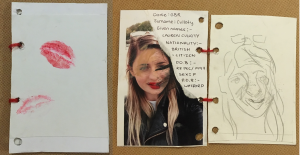I chose to read KRAPP, P. (2011) Noise Channels: Glitch and Error in Digital Culture. Minneapolis: University of Minnesota Press. This book is an analysis and study of creative expression in digital culture with the particular support of malfunction and glitch. Peter Krapp explains “there is arguably no art without any constraints at all” meaning all matter of subject has limitations. Chapter 1 rejects the view that hypertext may cause the end of creative writing. For example, he references historical writers and their collections of research references (index cards) as a similarity to hypertext, for example, he talks about Gerhart Hauptmann writing thoughts and notes on his bedroom wall. The book determines new media as not narrative based and that digital culture lacks predetermined order. Krapp stands up for hypertext and computer-based research pointing out memory as an unreliable source. He references art critics and curators e.g. Jasia Reichardt and discusses throughout the book Claude Shannon, who’s best known for information theory. Chapter 2 presents digital culture as a fuel of human rights movements. Krapp talks about hackers using systems as a means of freedom of speech. Krapp stands up for hacktivism saying “sit-ins and virtual blockades, e-mail flooders and computer worms declare themselves interactive digital art projects” showing it as a non-violent means of creating change in the same way artists hope they will change others. He mentions artists such as George Legrady who is particularly interested in the use of data processing as a mode of practice which is of particular interest to me and may inspire my practice.
Author Archives: Lauren Culloty
task 1
The passport exercise was about conveying my identity to others. Initially, I made a self-portrait, but it became problematic when it didn’t resemble me. I found problematic issues; How to pose in the artwork? Would wearing make-up be dishonest? In reflection, I established a new idea: A self-portraiture photograph with make-up exaggerating features on top. This is relevant as it represents coming to university feeling unready to show myself to everyone and depicts the use of make-up as a mask. Repeating the self-portrait without looking at the paper felt more genuine as I wasn’t making corrective changes based on what I thought it should look like. The Motivation for my idea came from seeing online complaints from transgender people about passport photo regulations, making them look very different to how they look every day. Inspired by classmates including fingerprints on their passports, I generated lipstick prints – changing the idea to work around my theme. A criticism of the piece was: “Would it be more appropriate if I wasn’t smiling, as passports don’t include emotion?”. My group suggested looking into Claire Tabouret’s portraits. I might develop the work making portraits with focal points centered on core features of make-up. Starting with a lipstick print and drawing a face around it. As well as look into the culture behind make-up.

